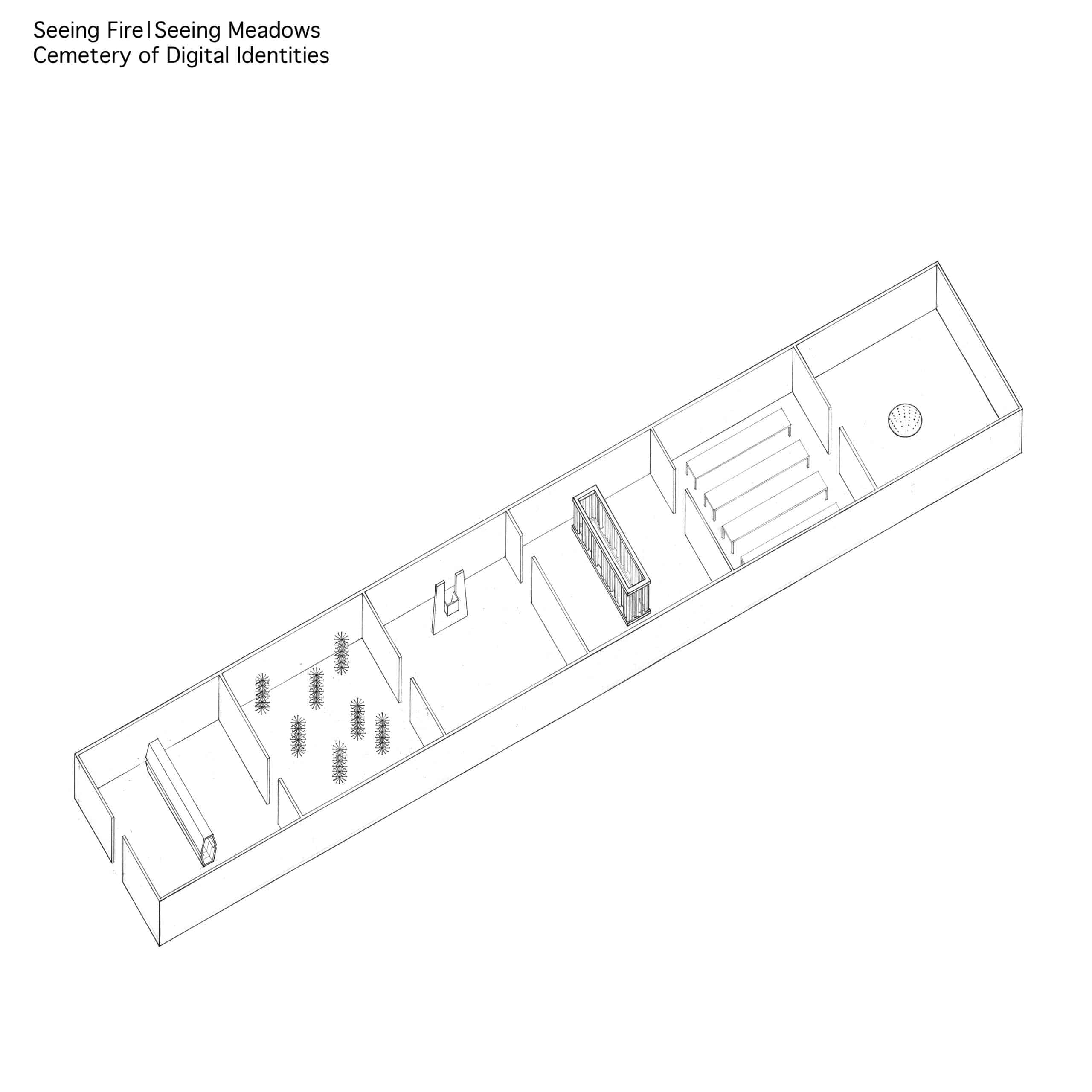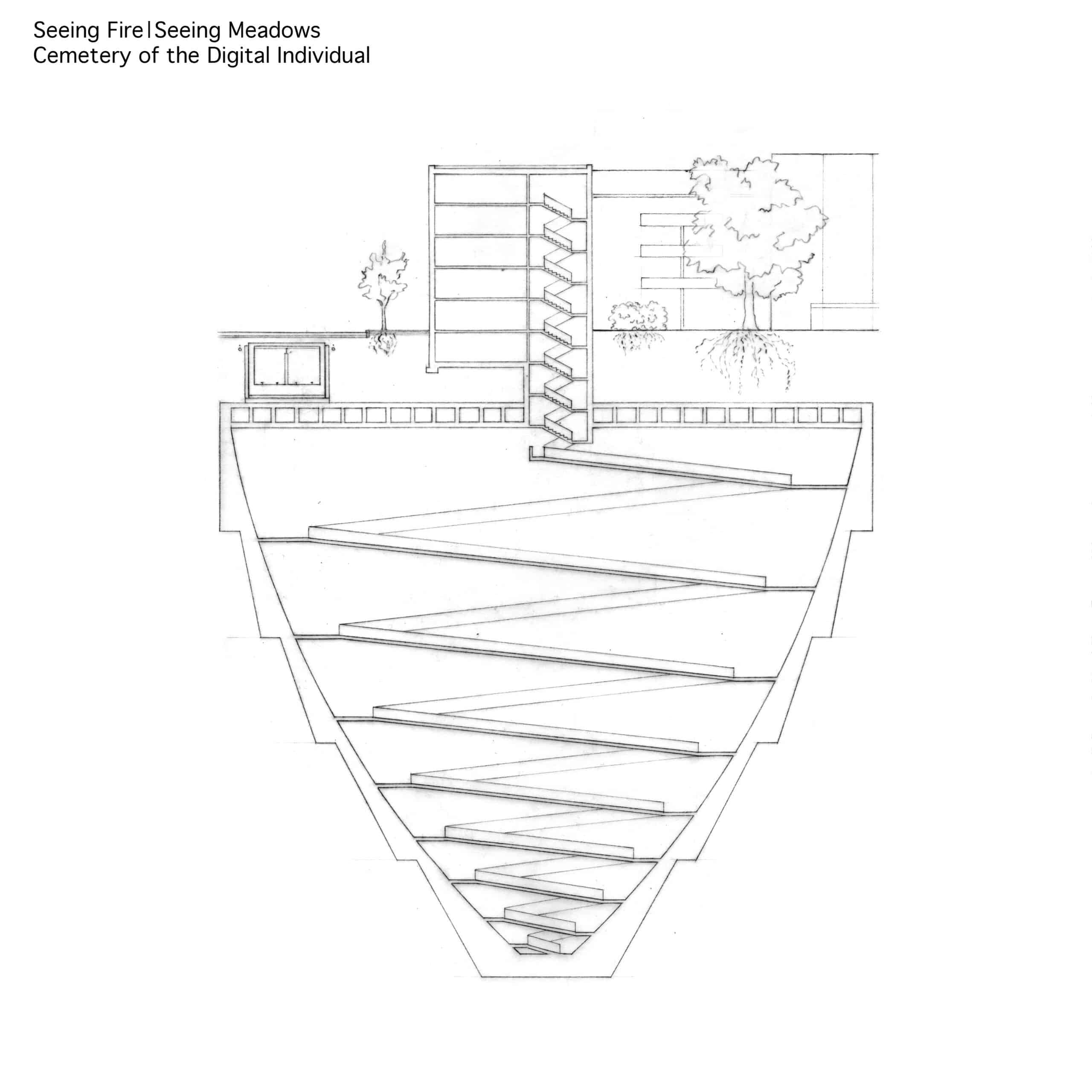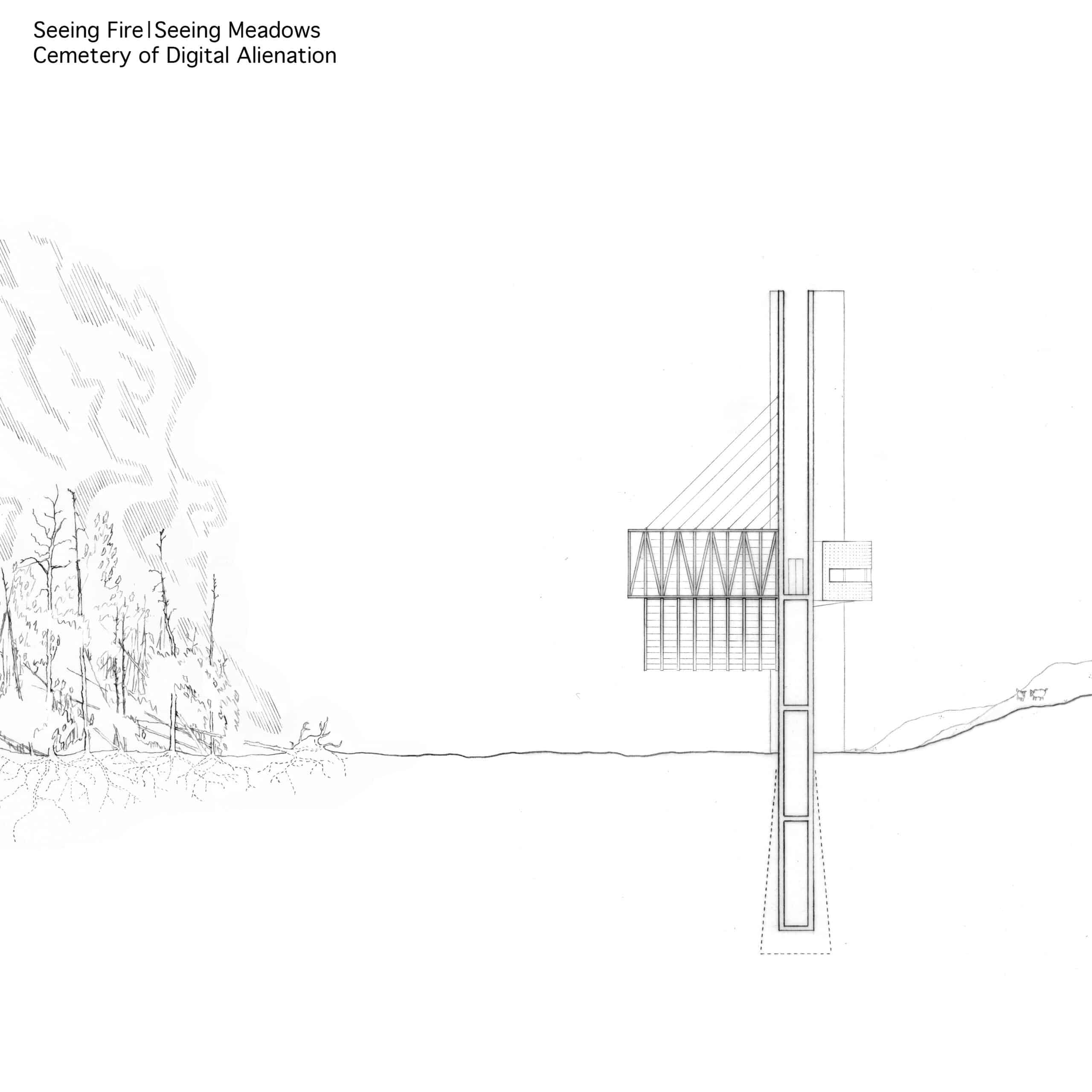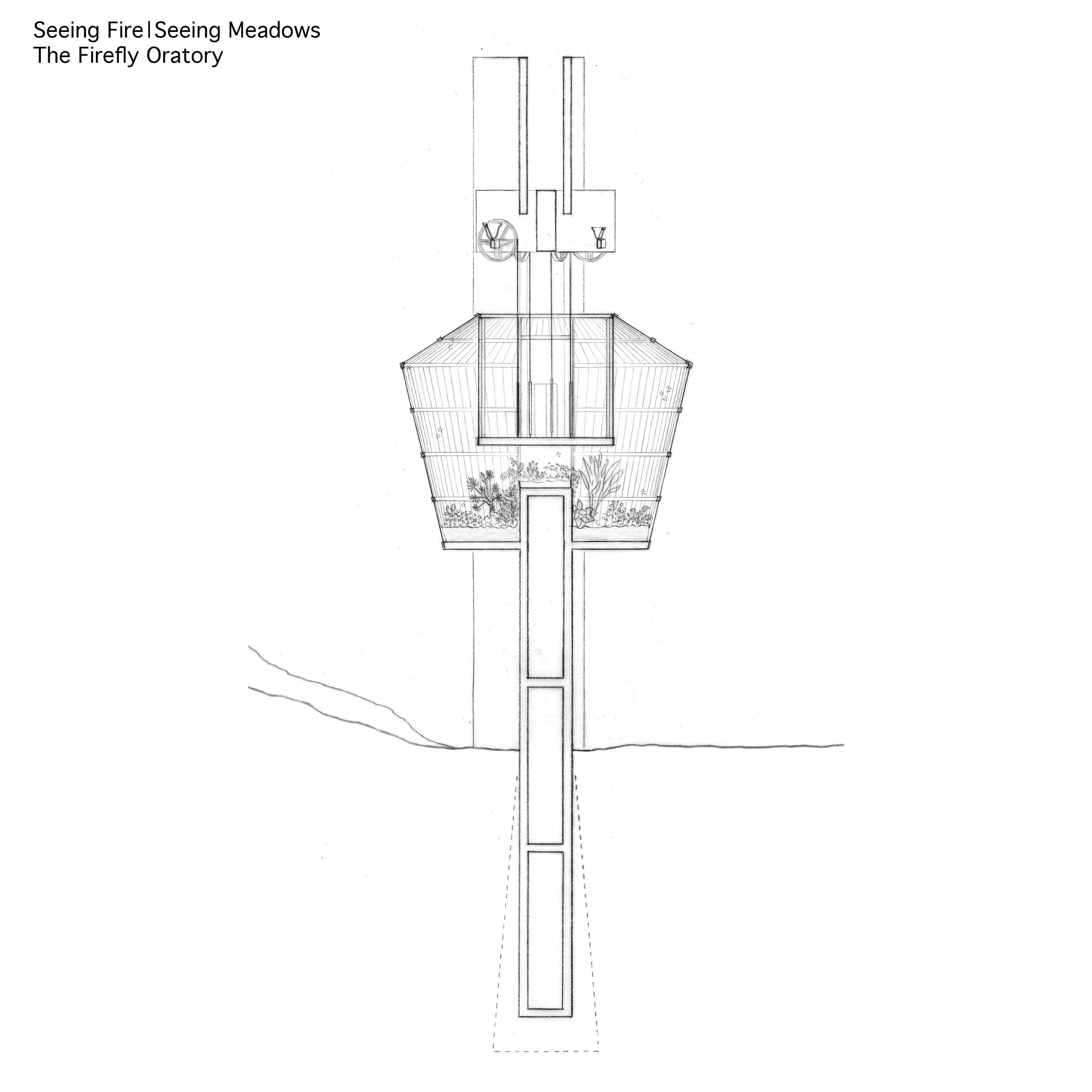Seeing Fire | Seeing Meadows
– Holger Kleine and Anna Kostreva
‘The architecture of agency is the architecture of the cemetery. The power to change is the power to say goodbye.’ (Epigraph, Seeing Fire | Seeing Meadows)
‘The cemetery is a place made for the living to spatialize their emotions; certain things can happen there that can’t happen in other places.’ (p. 10)
There are novels, and there are graphic novels, and there are neither-nor novels. Seeing Fire | Seeing Meadows by Berlin-based American architect Anna Kostreva is a sophisticated and gripping neither-nor case, sitting in its own genre, which one might call ‘archifiction’.
The first-person narrator, an architect called Natalie, intersperses no fewer than 45 drawings throughout the 150 pages of text. The drawings are not illustrations in the conventional sense but hands-on architectural projects expressed as sober line drawings. Their asceticism, which leaves plenty of room for the imagination, corresponds coherently with the tone of the novel, moving and worrying the reader (it touches upon many of the big questions of our era, particularly surveillance capitalism), but does not seek to dupe them. For the most part, the designs are an expression of an ‘architecture of pessimism’ in the sense of John Hejduk. Their dystopian beauty lies in their truthfulness, and not in the fact that one wants to see them realised. This is particularly true of the three cemetery projects that frame the novel: the ‘Cemetery of Digital Identities’, the ‘Cemetery of the Digital Individual’, and the ‘Cemetery of Digital Alienation’, each of which becomes increasingly radical and complex.



The interweaving of narrative and design does not point to any simple way out of the dilemmas of our time, but it does allow us to wander between worlds which can no longer be divided into the binaries of reality and dream, analogue and digital, inner world and outer world.
Excerpt from Seeing Fire | Seeing Meadows, 141–42:
March 21, 20XX
The lights come on and Winter wakes up. She stands up and looks toward the wall. A wall panel has slid away, creating an opening the size of a door, leading into a hallway. She steps up towards it and looks out. The hallway stretches out to her left and to her right, maybe thirty meters in either direction. At the end of the hallway to her left, it looks like elevator doors are open, waiting for her.
She walks out and I follow her. She goes towards the elevator and enters. It takes us up and releases us out the other side, onto a hallway that is basically the same as the one her cell is located on, except there is no roof. She looks up to the sky, open to the elements. There are slight changes in temperature, the coloration shifts above our heads and there is the sound of a breeze moving along the walls. I watch her stop in this hallway after a few steps and she cries.
March 21, 20XX
The lights come on and Winter wakes up. She stands up and looks toward the wall. The wall panel has slide away again. She walks out and I follow her once more. The elevator doors are open again, waiting. The machine takes us to the hallway that is open to the sky. The daylight pours in, a small feeling of freedom. She sits in the corridor and looks up at the blue sky. After a while, she notices that another elevator is waiting at the other end of the hallway. I watch her ready her body and take nervous, determined steps toward it.
This elevator takes us further down, to another open-air hallway sixty meters long. Again, down to a hallway. Again, up to a hallway. It seems to go on ten times, fifteen times, each time revealing another elevator daring Winter to continue her trek away from the cell.
Talking to herself, she wonders if she should turn around, before the hallways turn her around and she never makes it back at all. The cemetery and these hallways remind me of my dreams. And in my dreams, I never turn around. I’m too curious. Here with Winter, I still feel it’s my responsibility to keep my promise and stay right beside her.
Eventually she finds herself at the middle of one of the hallways and an opening the size of her cell door appears. I watch her peer through to a large rectangular room. There is a bright door on the opposite wall. However, the floor is composed of strips of jagged material.
Winter test her footing on the peaks of the first strip. The flooring seems to waver beneath her as she tries to keep her balance. Soon the whole strip starts to tip down in one direction.
Slowly, the jagged surface tilts so far it becomes a stair. It rotates from the center a full forty-five degrees, one side lifting up into the air, the other descending and revealing a dark cavern below the wall to the left.
Winter and I both carefully move down the stair to the dark space. My eyes adjust and I see that there are three screens mounted vertically one above the other on a wall curved like a ship’s hull. […]

Anna Kostreva, Seeing Fire |Seeing Meadows was published by Plural Studio in 2023. Find out more about the book at www.plural-studio.net.
Prof. Holger Kleine is a graduate of the Cooper Union and an architect in Berlin. Since 2010, he has been teaching as a professor for Artistic-Conceptual Design in the Interior Architecture department at the RheinMain University of Applied Sciences in Wiesbaden. His research focuses on public interior spaces. He is, among others, the architect of the German Embassy in Warsaw, author of the book The Drama of Space (2018), and curator of the exhibitions ‘New Mosques’ (Catalogue JOVIS 2014), ‘My Home is my Parcel’ (German Architecture Museum Frankfurt DAM 2020), and ‘The Salons of the Republic’ (DAM /JOVIS 2021). His design ‘Talking Station 1’ was exhibited at the Venice Architecture Biennale 2021 as part of the exhibition ‘Conceiving the Plan’. Currently, he is working on two extensive suites of autonomous architectural drawings.
Anna Kostreva is co-founder of Plural Studio, an office for architectural design and critical inquiry. She is a graduate of The Cooper Union School of Architecture, NYC, and the recipient of a 2009 Fulbright Grant for research on post-apartheid urbanism in Johannesburg, South Africa. She has taught architecture at TU-Braunschweig and The University of Bath as well as urban research at Humboldt University in Berlin. She recently published her first architectural novel, Seeing Fire | Seeing Meadows (UK: Plural Studio, 2023), which incorporates architectural projects as fundamental elements of the narrative.
